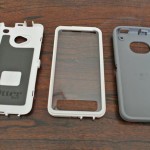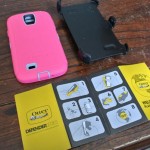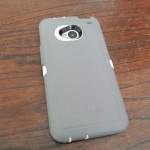 The name ‘OtterBox‘ is synonymous with tough, high-quality cases in the smartphone world, and as our smartphones get more powerful, yet also more delicate, it’s always good to know that there is a company that makes cases tough enough for (almost) everything. Today, we’ll be having a look at part of OtterBox’s line of Defender Series cases, in particular the ones made for the Samsung Galaxy S4 and HTC One. The Defender Series is one of the most protective cases I have ever seen, and the most protective that Otterbox has for the S4 and the One, but we’ll have a look at exactly why this is shortly.
The name ‘OtterBox‘ is synonymous with tough, high-quality cases in the smartphone world, and as our smartphones get more powerful, yet also more delicate, it’s always good to know that there is a company that makes cases tough enough for (almost) everything. Today, we’ll be having a look at part of OtterBox’s line of Defender Series cases, in particular the ones made for the Samsung Galaxy S4 and HTC One. The Defender Series is one of the most protective cases I have ever seen, and the most protective that Otterbox has for the S4 and the One, but we’ll have a look at exactly why this is shortly.
Before I start, don’t be alarmed by the colour scheme in the photo above: the HTC One Defender Series comes in a selection of 4 colours while the S4 Defender Series case comes in a whopping 15 standard colour combinations with the option to customize your combination of colours. Who said protective cases couldn’t be a fashion statement?
 In the box you’ll get the Defender Series case, a clip-on holster for your case and a small instruction pamphlet on how to assemble your case around your phone. And yes, you will have to assemble. The Defender Series is actually made up of 3 parts (4 if you count the holster); 2 parts make up the polycarbonate inner case that encapsulates the phone and the third is a silicon outer layer. Together, they make for potent protection against dropping, dust and scratching. The case also has a built in screen protector, so you won’t have to worry about getting one, unless you want to be overly protective.
In the box you’ll get the Defender Series case, a clip-on holster for your case and a small instruction pamphlet on how to assemble your case around your phone. And yes, you will have to assemble. The Defender Series is actually made up of 3 parts (4 if you count the holster); 2 parts make up the polycarbonate inner case that encapsulates the phone and the third is a silicon outer layer. Together, they make for potent protection against dropping, dust and scratching. The case also has a built in screen protector, so you won’t have to worry about getting one, unless you want to be overly protective.
 To get started with the case, you’ll have to strip off the silicon layer to expose the inner case. After some fiddling with the inner case, the front plate which includes the screen protector will separate, allowing you to place your phone inside. The inner case is actually quite fiddly if you aren’t terribly deft with your hands, so don’t expect to be able to strip your phone naked terribly quickly.
To get started with the case, you’ll have to strip off the silicon layer to expose the inner case. After some fiddling with the inner case, the front plate which includes the screen protector will separate, allowing you to place your phone inside. The inner case is actually quite fiddly if you aren’t terribly deft with your hands, so don’t expect to be able to strip your phone naked terribly quickly.
Once your phone is inside, however, the case makes a whole lot of sense. Firstly, your phone is held snugly in the polycarbonate (PC) inner case and then it’s engulfed by the silicon outer case, creating one of the most solid feeling cases I’ve ever felt. The Cygnett WorkMate is probably the case I’d compare this to, but with the solid PC inner case, the Defender feels a lot more rigid and weighty; whether the Defender is better than the WorkMate in a drop test, I can’t say, however.
In both cases, appropriate space has been left for soft buttons and mechanical buttons alike to be pressed as well as left space for the camera and sensors at the top of the phone. While the case is supposedly dust proof, and this was especially prevalent on the HTC One’s case, was that after a few minutes of playing with the case, I managed to get quite a lot of skin residue scratched off on the edge of the screen protector which subsequently fell into the case; without an adhering screen protector, this problem with dust and small debris would likely always exist for the Defender Series case, but it’s perfectly sufficient for stopping screen scratches and the like.
 Both cases offer ample protection for your audio and microUSB ports with a heavy-duty flap that  fits snugly with the rest of the case. The camera and speaker insets are very deeply housed and are likely more than protected from almost all accidents. The holster is the last piece of the Defender case and is quite a nice touch for those of you who wish to take your smartphones into slightly more rugged environments. The case has been designed to fit into the holster in all possible orientations; screen facing out, or screen facing in, and the clip that holds the case in the holster is actually quite stiff and won’t release your phone and case unless you really want it out.
Both cases offer ample protection for your audio and microUSB ports with a heavy-duty flap that  fits snugly with the rest of the case. The camera and speaker insets are very deeply housed and are likely more than protected from almost all accidents. The holster is the last piece of the Defender case and is quite a nice touch for those of you who wish to take your smartphones into slightly more rugged environments. The case has been designed to fit into the holster in all possible orientations; screen facing out, or screen facing in, and the clip that holds the case in the holster is actually quite stiff and won’t release your phone and case unless you really want it out.
 The holster also comes with a 360 degree rotatable clip on the back meaning you can mount and orient your smartphone however you like on your belt, bike, saddle, etc. The only gripe I have with the clips on the holster is that they might be a little stiff and a little too fiddly for those with older fingers. Apart from that, the holster is a very nice touch for the very outdoors-geared case.
The holster also comes with a 360 degree rotatable clip on the back meaning you can mount and orient your smartphone however you like on your belt, bike, saddle, etc. The only gripe I have with the clips on the holster is that they might be a little stiff and a little too fiddly for those with older fingers. Apart from that, the holster is a very nice touch for the very outdoors-geared case.
The OtterBox Defender Series cases are absolute monster cases and I don’t doubt they could undergo and survive unbearable batterings on your standard outdoors adventure. For all the little niggling issues it has though, it is definitely one of the most protective cases I have ever seen for the HTC One and Galaxy S4, very much living up to the OtterBox name.
Priced at either $49.95 or $59.95 USD depending on the colour scheme/theme you get, the OtterBox Defender Series cases for the HTC One and Galaxy S4 are on the more expensive side of cases, but for your money you get a supremely protective case which will extend the range of environments your smartphone can exist in safely (except probably water).
Galaxy S4 Defender Series Case – starts at $49.95
HTC One Defender Series Case – starts at $49.95
For more information about OtterBox, or to look up Otterbox’s other cases for HTC One and Samsung Galaxy S4, have a look at the links below:
OtterBox Samsung Galaxy S4 cases
Gallery of photos





























